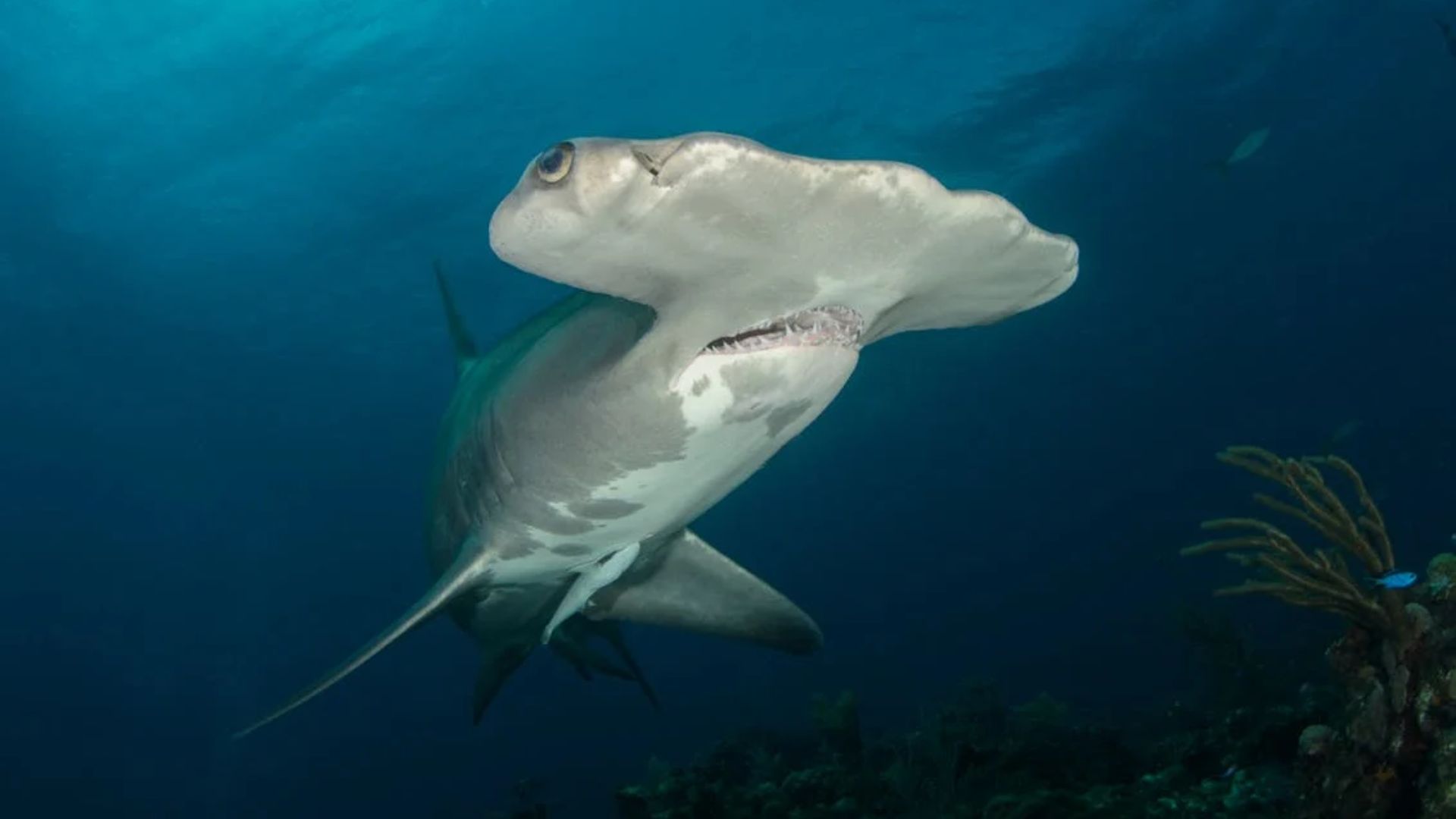Hammerhead sharks should be the poster child of evolution. This new shark species is relatively young and arrived roughly 25 million years ago, while other sharks roamed the ocean with dinosaurs.
Hammerheads evolved into their unique head shape to hunt sting rays and other prey and have a 360-degree view. Like me, they prefer to swim in the warm coastal waters and cruise the sandy ocean floor.
They share the Pacific with blue whales and drift along the coast of Central America past Costa Rica. It was along the warm Pacific that I had an encounter with the severed head of a juvenile hammerhead shark.
The great hammerhead shark is critically endangered and on the IUCN Red List, like whale sharks. Humans, sportfishing, commercial fishing, shark culling, and ocean pollution are the main threats to the survival of hammerhead sharks.
Top 12 Most Exhilarating Facts About Hammerhead Sharks
- Hammerhead sharks are easily recognized in the ocean due to heads, known as cephalofoil
- Hammerheads have gray-green to olive bodies with white bellies
- The average body length of hammerhead shark is 3 to 20 feet
- The average weight of hammerhead shark lis 300 lbs-1000 lbs
- Hammerheads possess eyes enabling 360-degree vision
- Hammerhead sharks have a top speed of 25 mph
- Hammerheads are carnivores, except for one specie that eats on greens
- Hammerhead sharks prefer to live in warm coastal waters
- There are total 10 species of hammerhead sharks (American Oceans)
- Hammerhead shark has a gestation period of 8 to 12 months
- Hammerhead sharks have lifespan of 20 to 30 years
- According to IUCN, hammerheads sharks are near threatened
Scientific Classification of Hammerhead Shark
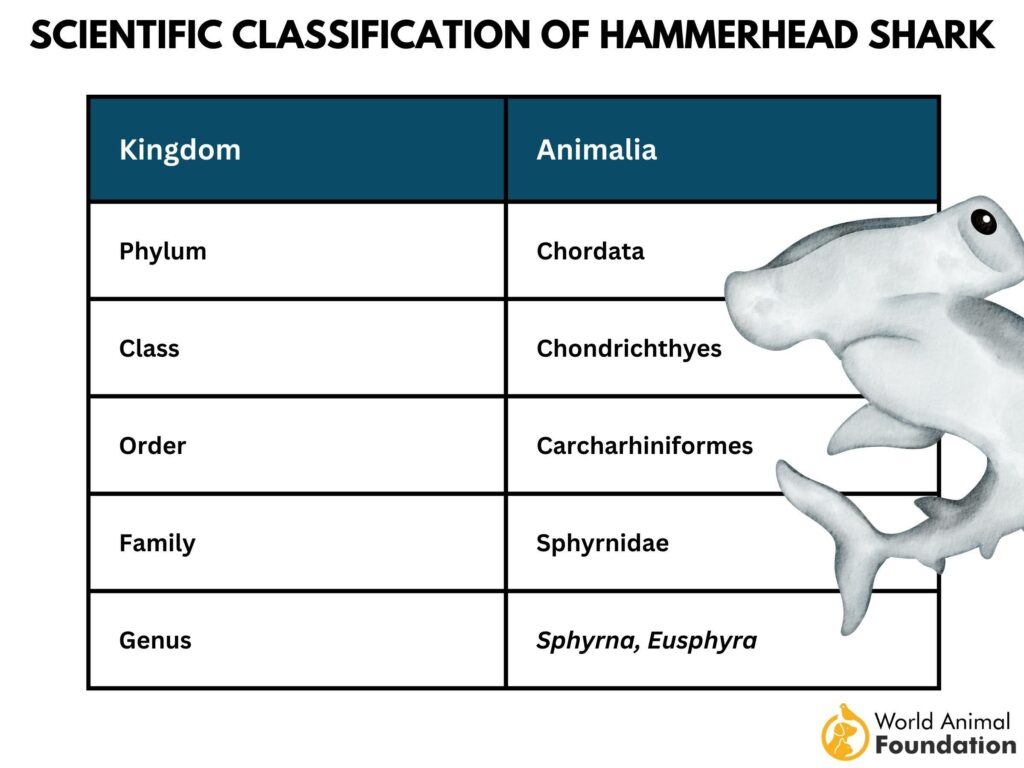
Hammerhead Shark Facts
Great hammerhead research teams suggest there are only 200 great hammerheads left.
Hammerhead Sharks Are Widely Recognized in the Ocean for Their Distinctively Shaped Heads, Known as Cephalofoil (American Oceans)
The cephalofoil-designed head gives sharks the depth perception they need to survive and hunt. Their mouths are on the bottom and are lined with sharp teeth. (source)
Cephalofoil Aids Hammerhead Sharks in Mobility, Perception, and Hunting (American Oceans)
This unique head design also acts as a tool when hammerhead sharks pin their prey and wait them out.
Hammerheads Possess 5 Gill Slits (Shark Research Institute)
Hammerheads belong to the class of Chondrichthyes, meaning cartilaginous fish. Gills intake oxygen and expel carbon dioxide, and hold their breath when hunting. (source)
Hammerheads Possess Eyes Enabling 360-Degree Vision but Lack Frontal Eyesight (Live Science)
Researchers established through testing that hammerheads have stereo vision like humans. Stereo view means that each eye sees the same object slightly differently and adds depth perception. However, they have a blind spot in the middle of their nose. (source)
Hammerheads Have Inhabited the Planet for the Past 20-25 Million Years (Phys.org)
Sharks are an ancient species. When hammerhead sharks evolved, they underwent other changes. Some species became smaller or larger, and the hammer-shaped head adapted too, likely from environmental pressures. ( I predict a plastic version in the future.) (source)
Hammerhead Sharks Have a Top Speed of 25 mph (Ead.gov)
Great hammerheads are the largest species and are agile swimmers that cover vast ocean distances, swimming at 25 mph. (source)
Hammerhead Shark Has a Gestation Period of 8 to 12 Months (CMS)
Depending on the subspecies of hammerhead sharks, they have different gestation periods and give birth to live pups in litters of 6 to 50, influenced by the parent’s size. (source)
Hammerhead Sharks Have an Average Lifespan of 20 to 30 Years (Florida Museum)
Many hammerhead sharks live long lives. Some great hammerheads live up to 44 years, and scalloped hammerhead sharks reach 35 years. (source)
Hammerhead Sharks Are Exploited for Sports, Shark Finning Industry, and Overfishing (MDPI)
All marine life is at the mercy of ocean pollution and overfishing. Hammerhead populations are in decline, and countries like Indonesia have prolific illegal fishing practices. In 2017, Indonesia alone landed 268 tons of hammerheads, which marks the highest depletion of hammerhead sharks. (source)
What Does a Hammerhead Shark Look Like
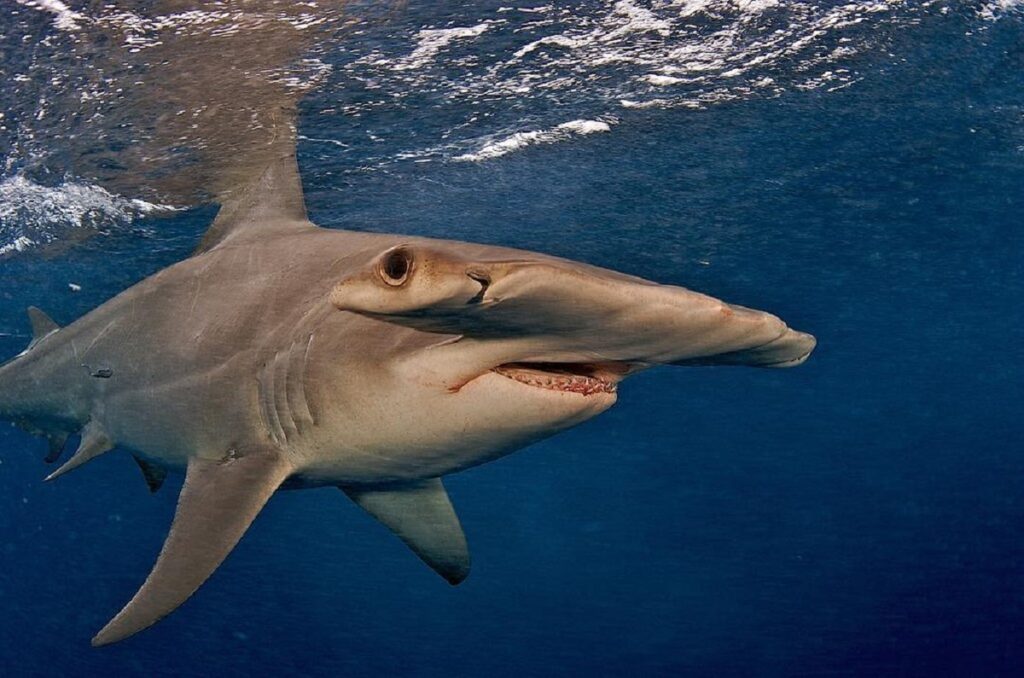
One only has to see an image of a hammerhead’s distinctive shape to identify this unique sport fish.
Hammerheads Have Gray-Green to Olive Bodies with White Bellies (Dutch Shark Society)
Aside from their hammer-like head, these sharks have a typical shark-like body covered in light grey or olive green scales. Some have white or striped bodies that act as camouflage when seen from below. (source)
Their Distinctive Feature Is a Flat Hammer or Shovel-Shaped Head (American Oceans)
Hammerheads evolved their unique shovel-head millions of years ago. This unusual shape sets them apart from most species and helps with hunting and depth perception.
Hammerheads Have Mouths Located on the Underside of Their Heads (National Geographic)
Although these heads look cumbersome, hammerhead sharks feast on stingrays, bony fish, crabs, squid, and other marine creatures. Their mouths are small but lined with teeth that cut like a serrated saw blade. (source)
Hammerhead Shark Size
There are ten known types of hammerheads. Each is similar yet unique.
The Body Length of Hammerhead Shark Measures Between 3 to 20 Feet (National Geographic)
Not all hammerheads are created equal. The smallest hammerhead species is the bonnethead shark, which measures 2.6ft to 3 ft and has a distinct round cephalofoil head.
Great hammerheads are the largest members of the Sphyrnidae family and reach anywhere from an average of 15 ft to a maximum of 20 ft.
The Average Weight of Hammerhead Shark Lies Between 300 lbs-1000 lbs (National Geographic)
Depending on the hammerhead group, the weight stats change drastically. Bonnetheads are very small and weigh between 20 to 25 lbs. Great hammerheads are formidable and weigh, on average, 510 lbs but can reach just shy of a 1000lbs. Females are larger.
Among All Hammerhead Species, the Great Hammerhead Is the Largest One (Mokarran.org)
A squat-headed hammerhead shark is prized in commercial and recreational fishing. Their sickle-shaped fins are a delicacy in Asia. The largest hammerhead on record was 610 cm or 20ft. (source)
Hammerhead Shark Mouth
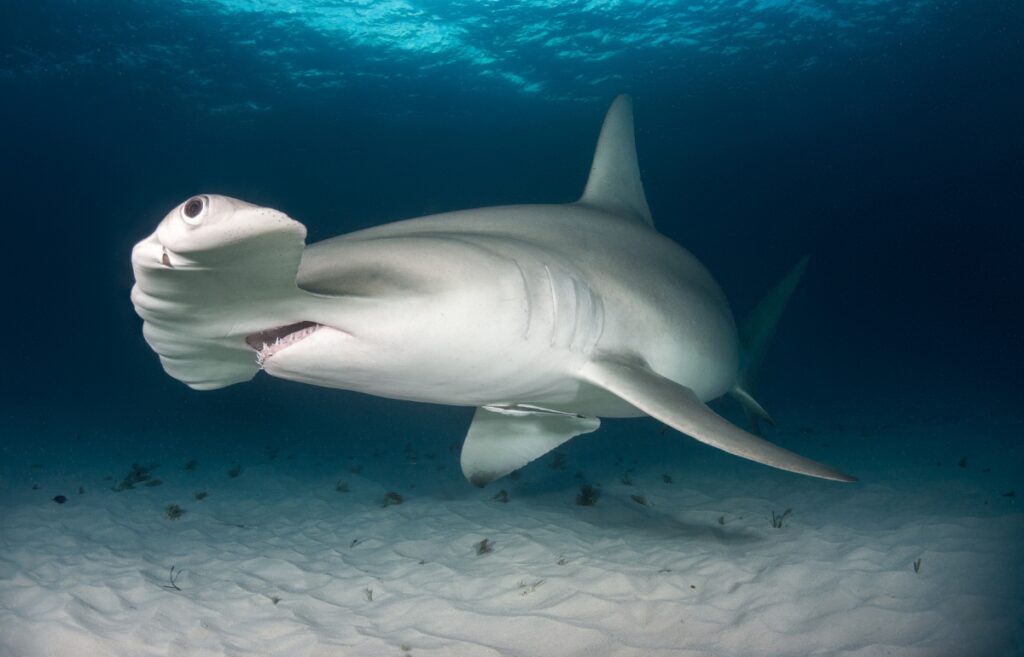
Hammerhead Has a Small Mouth, in Comparison to Its Head (National Geographic for Kids)
Although a hammerhead’s mouth seems small, it’s ideal for feasting on its carnivore diet, though the bonnethead is omnivorous and eats blue crabs with a seagrass salad.
Inside the Mouth, There Are Rows of Jaws, and Each Jaw Contains 24 to 37 Teeth (Dutch Shark Society)
Not all shark species have the same amount of teeth or shape. The number of rows also depends on the type, but on average, there are upwards of 30 rows of teeth on each jaw in a series of five, meaning they have 300 teeth. A great white shark might go through 35,000 teeth in its lifetime. (source)
Hammerhead Shark Anatomy
A great white shark and orca have distinct dorsal fins that slice through the surface. Hammerhead sharks also have similar dorsal fins.
The First Dorsal Fin Is Tall, Pointed, and Curved Like a Scythe (Florida Museum)
Like their unusual head shape, the dorsal fin of hammerheads rides high on their back and has a slight curve. This fin helps stabilize them in the water, but hammerheads can swim sideways. (source)
The Second Dorsal Fin Is High and Has a Pronounced Concave Rear Edge (Florida Museum)
Most sharks have eight fins. The dorsal fins are the most pronounced and visible, but the two pectoral fins help sharks steer and generate lift. This set of fins is behind the head. Dorsal fins help to stabilize and prevent rolling.
The Hammerhead’s Teeth Are Triangular but Don’t Have Prominent Serrations (Florida Museum)
Hammerheads are carnivores and need razor-sharp teeth to feed. While the vast number of teeth acts like a serrated blade, each individual tooth is smooth and lacks serration. Their teeth are small comparatively.
What Does a Hammerhead Shark Eat
Hammerhead sharks have a varied diet of marine life. Humans aren’t at risk of becoming a hammerhead snack.
Hammerheads Are Carnivores, Except for One Species That Eats Greens (Dutch Shark Society)
Squid, fish, crustaceans, octopuses, small sharks, and stingrays are on the menu. The great hammerhead is also known for eating members of its immediate family.
Hammerhead Shark Feeds on Small Fish, Stingrays, Octopus, and, in Some Cases, Even Seagrass (National Geographic)
Of the nine hammerhead shark species, only one is an omnivore and eats meat and seagrass. Hammerheads have a varied carnivore diet of marine animals, from small fish to other sharks.
Hammerheads Evolved Tolerance to Stingray Stings (National Geographic)
Hammerheads are a fine example of evolution, and since they enjoy eating stingrays, they’ve developed a tolerance to the painful barbs.
Where Do Hammerhead Sharks Live
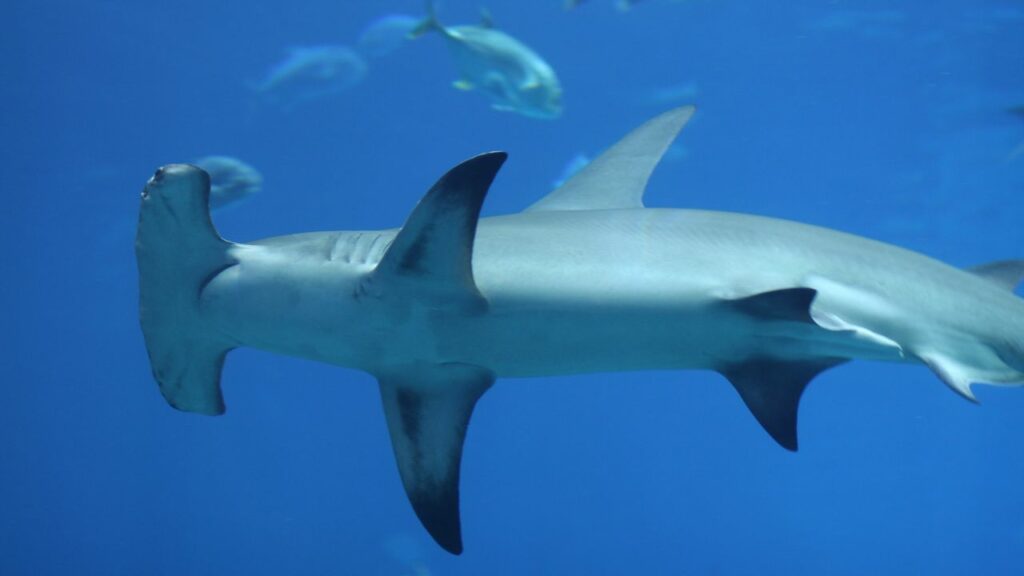
Although some hammerhead shark species are endangered, they have a broad aquatic habitat.
Hammerhead Sharks Prefer to Live in Warm Coastal Waters (SOEST Hawaii)
Scientists have much to learn about hammerhead sharks. Hammerheads, like most shark species, are ectotherms, meaning cold-blooded, and their body temperatures adjust to their surroundings. Sharks like the Mako shark and Great White are partially warm-blooded.
Scalloped hammerheads hold their breath to keep their bodies warm in deep water. (source)
They Inhabit Warm Waters of Central and Southern America, Asia, Africa, and Australia (SOEST Hawaii)
Hammerhead sharks thrive in warm water along the shorelines and continental shelves of Central America, South America, Asia, Africa, and tropical islands like Hawaii.
Hammerhead Shark Species
The Hammerhead shark species is a small group from the Sphyrna and Eusphyrna genera. They’re found worldwide.
There Are a Total 10 Species of Hammerhead Sharks (American Oceans)
It gets confusing when we read about hammerhead shark species. There are currently ten known species. The winghead hammerhead falls into its own genera, and its cephalofoil can be as wide as half its body length. (source)
Worldwide, There Are 9 Species of Hammerhead Sharks Under the Genera Sphyrna (Florida Museum)
When people discuss hammerhead sharks in the nine species, they omit the winghead shark. The nine species are these sharks: the great, scalloped, smooth, smalleye, Carolina, whitefin, scalloped bonnethead, scoopheads, and bonnethead.
1 Species of Hammerhead Shark Exists Under the Eusphyrna Genera (Florida Museum)
The winghead is the only hammerhead in the Eusphyrna genera. These endangered hammerhead sharks live in the tropical region of the western Into-Pacific, from the Persian Gulf to New Guinea and Queensland to Western Australia.
Baby Hammerhead Shark
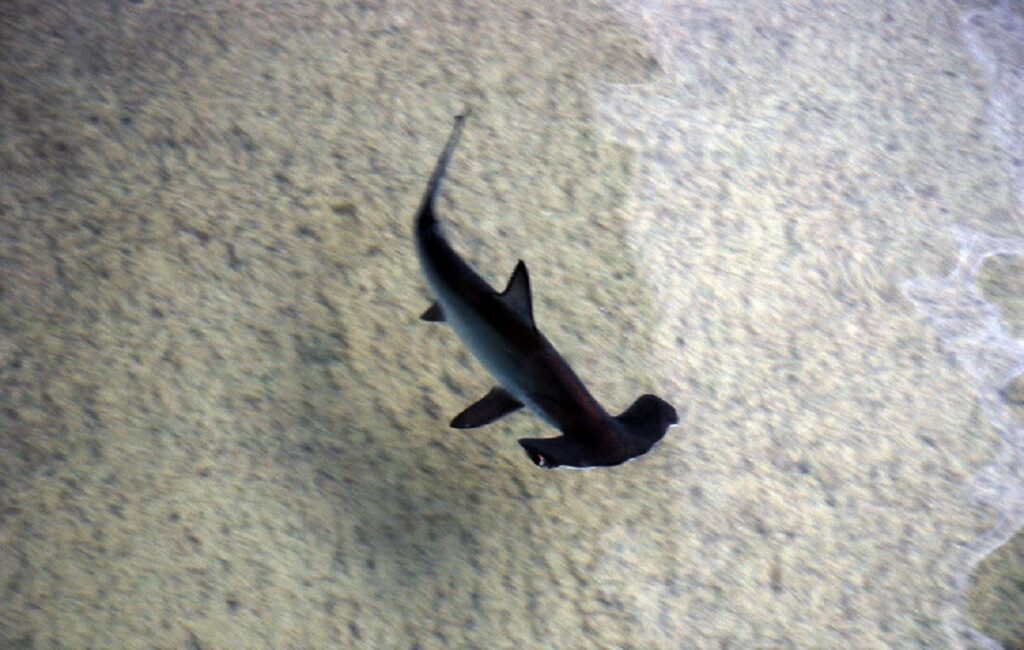
Hammerheads are not spawned from eggs like other fish.
Hammerhead Species Can Reproduce Through ‘Virgin Births’ and Give Birth to Live Pups (NCBI)
Hammerhead shark females can fertilize their own eggs. The shark’s size can determine the number of pups in the litter. Some sharks lay eggs; others give birth to live young. (source)
A Single Litter Can Vary in Size, Ranging From 6 to Around 42 Pups (Mokarran.org)
Pups can instantly fend for themselves, and their mother leaves them in shallow water with up to 50 siblings. (source)
When a Hammerhead Pup Is Born, Its Head Is Comparatively Rounder Than That of Its Parents (National Geographic)
Hammerhead pups develop their symbolic head shape as they grow up. When they’re born, their head is rounder, which makes their birth easier, coming through the birth canal. Pups swim forward to breathe.
Hammerhead Shark Predators
Hammerhead sharks have no natural predators except humans. Thousand of hammerheads from all species die as by-catch, vessel strikes, pollution, culling, and sport fishing.
Naturally, They Don’t Have Predators Except for Humans (To Save Animals)
Great hammerheads are on the IUCN red list. Fishermen slice off their prominent fins, valued for shark fin soup. In captivity, 90% of hammerheads die. (source)
While Instances of Attacks by Orcas, Dolphins, and Other Shark Species Have Been Documented (Vanderbilt Museum)
Hammerheads are important predators, and occasionally, they become victims to roaming orcas, dolphins, and other sharks, but they aren’t common. (source)
Are Hammerhead Sharks Endangered
Yes, several species are on the IUCN Red List: scalloped hammerhead—globally; Great hammerhead—globally; Smooth hammerhead—vulnerable globally
According to IUCN, Hammerhead Sharks Are Critically Endangered and Are Near Threatened (IUCN)
Good fortune and a symbol of luxury make hammerhead shark fins a delicacy. The pressure on these semipelagic sharks from nearshore and high-sea fisheries is tremendous. In Hong Kong, millions of hammerhead fins are sold as a status symbol. (source)
Facts About Hammerhead Sharks
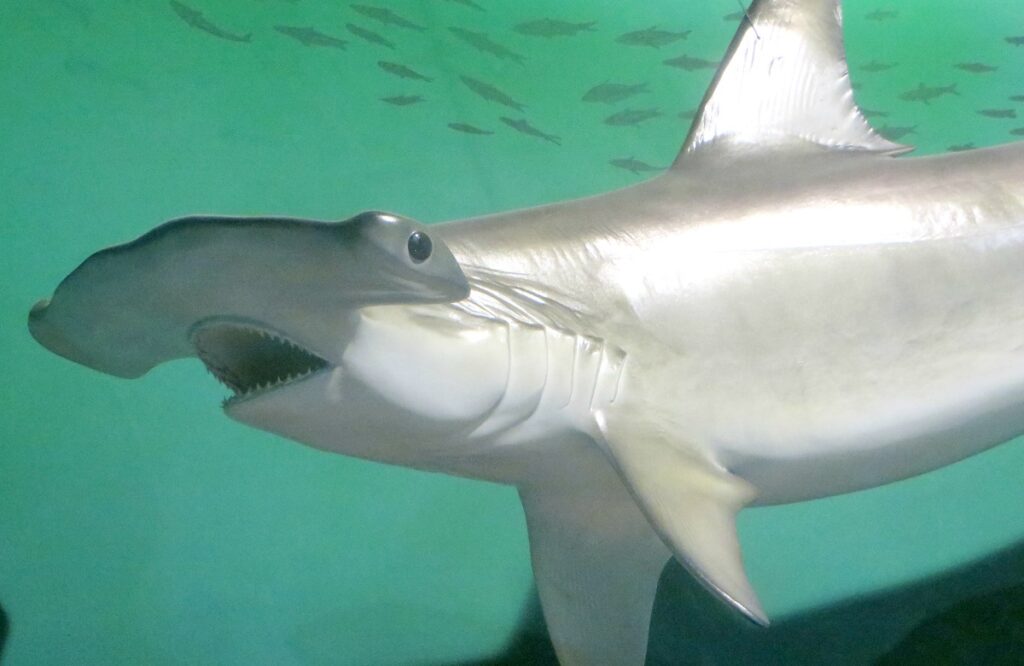
Hammerhead Sharks Do Get Tanned (California State University)
Scientists are keen to observe and study this tanning phenomenon and hope to use their findings to treat melanoma in humans. (source)
The Great Hammerhead Sharks Are Capable of Swimming Sideways (Nature Journal)
Great hammerheads have a unique design that allows them to swim sideways. Their prominent dorsal fin helps lift them to swim on their side. Tagged sharks prove they spend 90% of swimming on a slight angle, reducing drag. (source)
Hammerheads Often Travel in Groups (Dutch Shark Society)
It must be a stunning sight to see 500 hammerheads converge and swim together. However, they only do this during daylight.
Hammerheads Possess Ampullae of Lorenzini, Enabling Them to Detect Prey Through Electrical Fields (Ocean Conservancy)
This isn’t unique to hammerheads but sharks in general. These fish have mucus-filled pores on their snouts, named for Stefano Lorenzini, who discovered this anatomical trait in the 17th century. (source)
Hammerheads Don’t Lay Eggs (NOAA Fisheries)
Hammerheads give birth to up to 50 pups. These pups don’t hatch but are live births and must fend for themselves. (source)
Hammerhead Sharks Sometimes Exhibit Cannibalistic Behavior (Oceana)
Sometimes, in the wild, mothers eat their young. Hammerhead sharks are carnivores and consume a wide range of marine animals, including smaller members of their own species. (source)
The Hammerhead Shark Species With the Broadest Head Is the Winghead Shark (Edge of Existence)
The winghead shark is the 10th species of hammerhead. Its wide and prominent snout resembles a wing and, unfortunately, makes it a target for overfishing and getting entangled. It’s a threatened species without conservation plans.
Hammerhead Shark Fun Facts
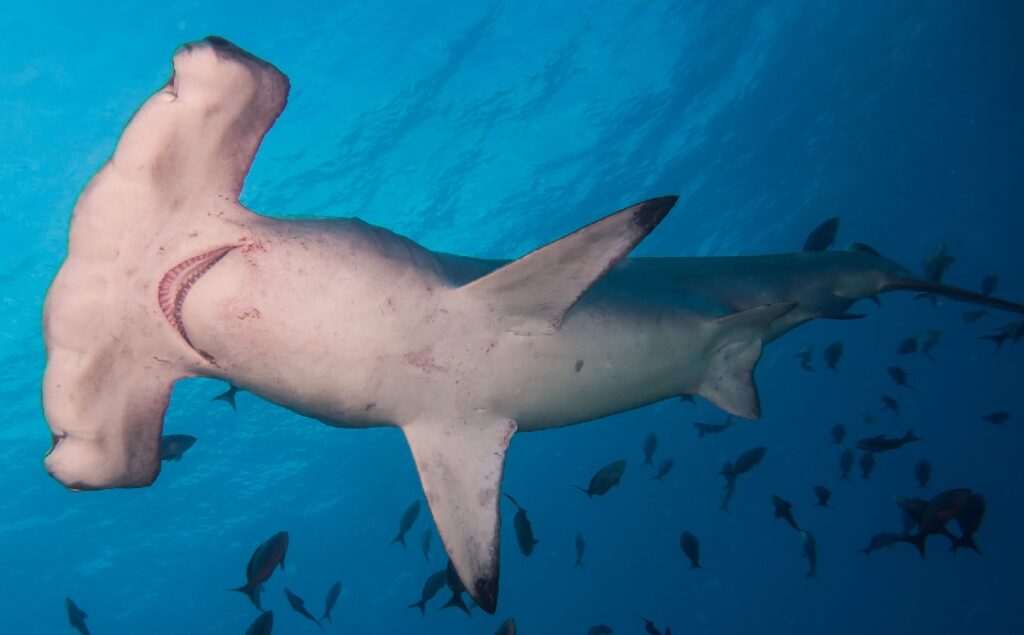
Most hammerhead species are vulnerable or critically endangered. However, the United States National Marine Fisheries Service (NMFS) voted against protecting them.
1. Nine known species exist, and each is unique.
- Scalloped hammerhead
- Great hammerheads
- Smooth hammerheads
- Smalleye hammerheads
- Carolina hammerheads
- Whitefin hammerheads
- Scalloped bonnethead
- Scoophead
- Bonnethead
- Winghead is the tenth species of hammerhead shark
2. Hammerheads have a natural defense mechanism against stingray barbs.
3. A 360-degree view and a blind spot make hammerhead sharks a truly remarkable shark species.
4. A hammerhead head design allows them to attack prey and pin them to the sandy sea bed for long periods.
5. Cephalofoil is the scientific name for the pronounced hammerhead shape.
6. Hammerhead sharks travel in schools of up to 500. However, at night, hammerhead sharks travel alone.
7. Female hammerheads can fertilize their own eggs; hence, virgin births to live young.
8. Great hammerheads can swim and drift on a tilt because their fins have adapted to different lengths.
9. Hammerheads tan when cruising warm shallow waters. Their tan turns dark gray, and they don’t get skin cancer.
10. Sharks have dominated the ocean for 420 million years, while hammerheads are only 20 to 25 million years young.
More Hammerhead Shark Facts for Kids

FAQs
Hammerhead sharks are a fascinating and unique species of fish.
Why Do Hammerhead Sharks Have a Hammerhead?
Evolution equipped hammerheads with this unique hammerhead shape to help them hunt and have better depth perception.
How Big Do Hammerhead Sharks Get?
It depends on the type, but they can get up to 20 feet long.
Are Hammerhead Sharks Dangerous?
Hammerheads are shy and elusive and don’t pose a threat to humans.
Do Hammerhead Sharks Lay Eggs?
No, hammerhead sharks give birth to live pups.
What’s the Hammerhead Shark’s Scientific Name?
Sphyrna is the genera of nine hammerhead species; the tenth is Eusphyrna for the winghead shark genera. Sphyra is Greek for hammer.
Are Hammerhead Sharks Aggressive?
Hammerheads are shy and not aggressive.
Do Hammerhead Sharks Attack Humans?
Since 1580, there have been 17 shark attacks on humans. Most hammerheads are too small to cause serious harm.
Conclusion of Hammerhead Shark Facts
Hammerhead sharks share the vast ocean with blue whales, tiger sharks, humpback whales, and millions of vessels. These unique sharks omit electrical impulses to hunt and eat squid, fish, lobsters, and occasionally divers—kidding! It would be a shame to lose these incredibly smart members of the genus Sphyrna because of carelessness.


